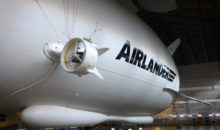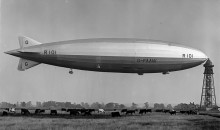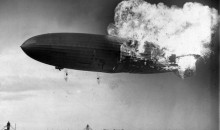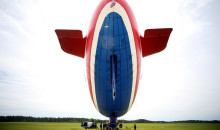On This Day: The Suffragette Airship
The struggle to enfranchise women in the United Kingdom in the first couple of decades of the 20th century was long and difficult, but the suffragettes were masters of the art of gaining media attention with elaborate stunts.
One of the most audacious examples of this was an airship flown over London in 1909 by Muriel Matters.
Muriel Matters was born in Australia and was a professional actress before coming to England. She became involved with the suffragette movement and earned her spurs by chaining herself to a grille in the Ladies Gallery of the House of Commons a side product of which was she was one of the first women to make a speech in the House of Commons.
On 16 February 1909, King Edward officially opened Parliament for the coming year. As a part of the festivities there was a precession to the Houses of Parliament led by His Majesty. To gain attention to the suffrage cause, Matters’ decided to hire a dirigible air balloon (similar to a modern-day blimp in appearance) and intended to shower the King and the Houses of Parliament with pamphlets emblazoned with the words “VOTES FOR WOMEN”.
Thirty years later she recalled the experience:
Audio © BBC
That morning I went to Hendon and met Mr Henry Spencer who had his airship all ready near the Welsh Harp*. It was quite a little airship, eighty eight feet long (25m), and written in large letters on the gas bag were three words, Votes For Women. Below this was suspended an extremely fragile rigging carrying the engine and a basket, like those used for balloons. We loaded up about a hundredweight of leaflets, then I climbed into the basket, Mr Spencer joined me, and we rose into the air.
* now known as the Brent Reservoir.
They rose to an altitude of 3,500ft (1,000 metres) before levelling off. “It was very cold,” she said, “but I got some exercise throwing the leaflets overboard.” She described how Spencer would climb out of the basket and clamber like a spider across the framework to make adjustments to the engine. “Suddenly I realised that if he fell off, I hadn’t the first idea how to manoeuvre the airship.” she said. “Not that I was terribly bothered about that. I was too busy making a trail of leaflets across London.”
With the airship emblazoned with ‘Votes for Women’ on one side and ‘Women’s Freedom League’ on the other Matters scattered 56Ib of handbills on the streets and houses below as she went with leading members of the Women’s Freedom League, Edith How-Martyn and Miss Elsie Craig, in pursuit by car.
Unfortunately, the elements were against the suffragette movement on that day and the airship’s feeble motor was not enough to overcome the adverse winds. She never made it to the Palace of Westminster but drifted around the outskirts of London, passing over Wormwood Scrubs, Kensington, Tooting and eventually crash-landing in the upper branches of a tree in Coulsdon in Surrey after a trip lasting an hour and a half in total.
Despite failing to fly over the procession, led by King Edward, Matters considered the aerial adventure a great success. “The flight achieved all we wanted”, she said. “It got our movement a great deal of publicity, as you can imagine. In those days, the sight of an airship was enough to make people run for miles!”
An interesting footnote of this venture is that this was the first powered flight from what later became the London Aerodrome at Hendon which was to feature prominently in both World Wars. The aerodrome is also famous as a place of pioneering aviation experiments which include the first airmail, the first parachute descent from a powered aircraft, the first night flights, and the first aerial defence of a city. Today, Hendon houses the London branch of the Royal Air Force Museum which portrays the role of the Royal Air Force in the development of aviation and avionics in the United Kingdom.
Muriel Matters continued with her political life as an active member of the suffragettes lecturing all over the world and running (unsuccessfully) as the Labour Party candidate for the seat of Hastings in the General Election of 1924. She went on to study in Barcelona under Maria Montessori, the radical Italian educationalist, returning to work at Sylvia Pankhurst’s school in Bow, East London. Muriel died on 17 November 1969 in St. Leonards on Sea nursing home aged ninety-two.







